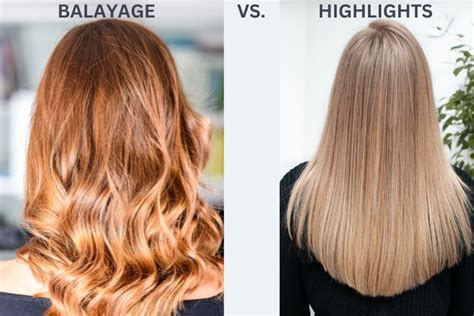1. What is Balayage?

Balayage is a French hair coloring technique that involves hand-painting highlights onto the hair, creating a natural, sun-kissed look. The term “balayage” translates to “to sweep” in French, referring to the sweeping motion used to apply the color.
Process:
- Hair is sectioned into small strands.
- Color is applied directly to the mid-lengths and ends of each strand using a brush.
- The hair is left to process for 20-30 minutes.
- The color is rinsed and toned.
2. What is Highlighting?
Highlighting is a traditional hair coloring technique that involves using foil or plastic wrap to isolate strands of hair and apply color. This technique can be used to create a variety of looks, from subtle highlights to bolder streaks.
Process:
- Hair is sectioned into small strands.
- Foil or plastic wrap is placed under each strand.
- Color is applied to the strands and covered with foil or wrap.
- The hair is left to process for 30-45 minutes.
- The foil or wrap is removed and the hair is rinsed and toned.
3. Key Differences Between Balayage and Highlight
| Feature | Balayage | Highlight |
|---|---|---|
| Application Method | Hand-painted | Foil/Wrap |
| Placement | Mid-lengths and ends | Roots to tips |
| Look | Natural, sun-kissed | Dramatic, defined |
| Maintenance | Less frequent touch-ups | More frequent touch-ups |
| Cost | Typically more expensive | Typically less expensive |
Factors to Consider:
- Desired look: Do you want a natural, blended look or bolder streaks?
- Hair type: Balayage may be more suitable for finer hair, while highlighting can work well for all hair types.
- Maintenance: Balayage requires less frequent touch-ups than highlighting.
- Budget: Balayage is typically more expensive than highlighting.
4. Motivations and Pain Points of Balayage and Highlight
Motivations:
- Balayage: Natural, sun-kissed look; Low-maintenance; Blends with natural hair color.
- Highlight: Dramatic, defined look; Can be used to create a variety of styles; Long-lasting results.
Pain Points:
- Balayage: Can be time-consuming to apply; May not provide enough contrast in darker hair.
- Highlight: Frequent touch-ups required; Can damage hair if not done correctly; Can look unnatural if overdone.
Balayage:
- Over-applying color, resulting in an unnatural look.
- Using too much heat during application, which can damage hair.
- Not blending the color properly, creating a patchy appearance.
Highlight:
- Using too narrow or wide foils, which can result in unnatural-looking lines.
- Overlapping foils, which can lead to uneven color.
- Leaving color on for too long, which can damage hair.
6. FAQs
- How often should I get balayage/highlights done? Every 6-8 weeks for balayage, and every 4-6 weeks for highlights.
- Do balayage/highlights damage my hair? When done correctly, both techniques can be done with minimal damage.
- Can I get balayage/highlights on dark hair? Yes, but it may require multiple sessions to achieve the desired result.
- How much does balayage/highlights cost? Prices vary depending on the salon, but typically range from $100-$500.
- Can I do balayage/highlights at home? It’s not recommended to attempt these techniques at home, as they require professional training.
- What are some alternative hair coloring techniques to balayage/highlights? Ombre, color melting, and smudging.
